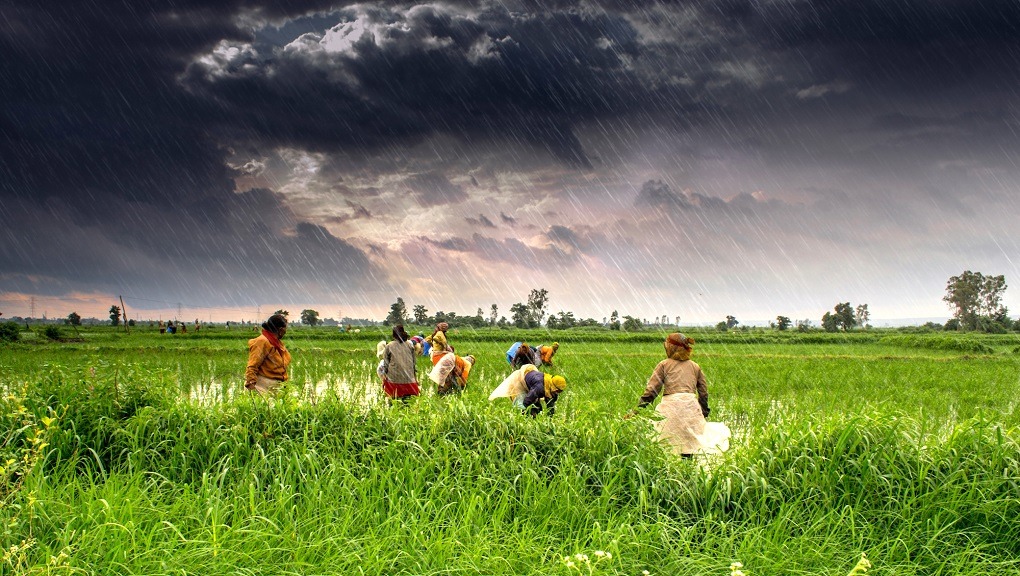 |
| Agriculture and climate change visible in one frame| Image source ICN world |
This blog discusses how the future of agriculture in India will be impacted by climate change and what conduct can be taken to alleviate its impact.
India is one of the world's largest agricultural producers, with a wide variety of crops grown in different regions of the country. There are millions of growers who depend on it for their livelihoods. It is the backbone of our country. According to the 2019-20 report of NITI Aayog, agriculture employs over 42.3% of the country's workforce and contributes about 16.5% to the country's GDP. However, climate change poses significant challenges to Indian agriculture, and these challenges may vary from region to region. Climate change is significantly disrupting the monsoon season, leading to changes in precipitation patterns, rising temperatures, and more frequent extreme weather events similar to floods and droughts. These changes have a major impact on Indian husbandry, impacting crop yields, soil health, and water vacuity.
I'll take you through what has happened in agriculture with the current crisis we are experiencing and the poor decisions which were made. Punjab was the starting point of the Green Revolution. We began it in the 1960s with the intention of feeding the nation, but over time we failed to learn from what had occurred there. Food production has increased from approximately 55 million tons to today. Our warehouses are bursting with the 300 million tons of cereals we produce.
 |
| Farmer Suffering Image Source Mentioned at the end |
The producers who actually suffered to make this happen are still suffering today, and we can see the natural resources completely depleted (thirty percent of the soils are destroyed), pesticide pollution, and stubble burning. Often, we mistakenly believe that what is happening in rural India has nothing to do with what is happening in cities, but today, if you look at the Punjab and Delhi, you can see the connection between the stubble burning which is happening in Punjab and Delhi. Every time they burn the stubble, smoke travels to Delhi, where air pollution levels are now so severe that residing there is difficult.
The western region, which includes states like Gujarat, Maharashtra, and Rajasthan, is known for its different agriculture similar to cotton, sugarcane, and fruits. nonetheless, climate change is expected to affect agriculture in the region. Changes in precipitation patterns and rising temperatures can reduce crop yields and increase water stress
 |
| Flood-affected crop areas of Karnataka. | Photo Credit: REUTERS |
Changes in precipitation patterns and rising temperatures can reduce crop yields and increase water stress. Long stretches of coastline in Maharashtra might put infrastructure and coastal communities in danger. According to the Intergovernmental Panel on Climate Change (IPCC) study, sea levels might rise by up to 1.1 meters by the end of the century, causing more flooding and coastal erosion.
Departmental figures show that Assam experienced a 21% decrease in rainfall between June 2021 and July 2021. It demonstrates how Assam's rainfall has decreased and its temperature has increased due to global warming. Over the past few years, the state has seen an increase in heat waves and devastating floods.
 |
| Glacier melting |IMAGE COURTESY OF ERIC RIGNOT |
There might be several broad effects of climate change on Indian agriculture that are important to note, aside from regional variations. As an example, alterations in rainfall patterns, such as severe floods or droughts, can cause planting seasons to be disrupted and result in decreased yields. Increased plant diseases and pest populations can further lower agricultural output. River irrigation, a vital component of Indian agriculture, might be disrupted by climate change. Relatively long-term river drying and short-term flooding from melting glaciers.
The nation has a lengthy coastline, and some significant agricultural regions that resemble the Ganges and Brahmaputra delta regions are in danger of flooding. Temperature variations can also have an impact on pollination patterns and pollinator populations, which could disrupt ecosystem functions vital to agriculture. Farmers may need to modify crop selection and irrigation practices as farmlands dry out as a result of altered rainfall patterns in order to maintain the land's productivity. As a result, agricultural prices may rise when crop production declines. The livelihoods of common people will be negatively impacted by higher crop prices resulting from lower crop production. The economy and export market of the nation is also badly impacted by declining agricultural quality.
The workforce will need to shift to different sectors. Demand for food in terms of quantity, quality, and variety will rise as the population grows. In order to fulfill those demands pressure on the limited amount of arable land will continue to grow. Agriculture won't be able to survive until we find a way to enhance crop yields. We will need to increase our crop yields somehow. For Instance, if we use the United States as an example, no other nation produces food as effectively as the US. The US has a similar level of total agricultural output to China, and India despite having a far smaller workforce and less area for farming. India will also have to do something similar to the US. There is also some geographical difference between both countries which will act as a blockade because in India plots are getting smaller and smaller with generation. If we somehow don’t solve this problem it will be really difficult in the future to get higher yields in agriculture.
In order to reduce the effects of climate change on agriculture and guarantee food security and livelihoods for millions of people in India, it will be necessary for growers, policymakers, and researchers to collaborate. We'll need to create a plan that works. This might include actions like creating drought-tolerant crops, improving irrigation efficiency, and assisting farmers in implementing sustainable agrarian practices like changing their crop to one that requires less water. growing crops that can withstand heat and drought better, or using drip irrigation or other alternative irrigation techniques. Mulching, crop rotation, and intercropping are examples of conservation agriculture techniques that can assist in preserving soil fertility and water supplies.
 |
| Nasa growing tomato in space |Image source India Tv |
Agriculture accounts for around 20 percent of greenhouse gas emissions. For instance, Paddy cultivation generates 10 crore tonnes equivalent in greenhouse gas emissions per acre. We all believe that agriculture is impacted by climate change, but it is also a significant contributor to climate change. As a result, unless we address this issue, it will be very, very difficult to increase yield productivity.
Bibliography
Karnataka, Tamil Nadu among 14 Indian states vulnerable to climate hazards: Report | Deccan Herald
Karnataka: Climate change brought intense rain, distress and losses to state- The New Indian Express
Tomatoes grown in space flying to Earth on Dragon spacecraft today | Watch LIVE - India Today
Agriculture and climate change (mckinsey.com)
https://www.niti.gov.in/indian-agriculture-towards-2030

No comments:
Post a Comment